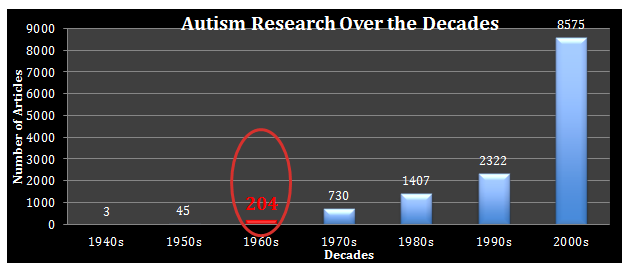The 1960s
Highlights
• Turning point in the history of autism research
• Many autism research groups and organizations formed
• Autism recognized as a biological disorder with neurological causes
• Autism differentiated from schizophrenia
• Brain abnormalities suggested to underlie autism
• Operant conditioning first attempted with autism
• Prevalence: 4.5 per 10,000 people

| 1940s | 1950s | 1960s | 1970s | 1980s | 1990s | 2000s |
Research in the 1960s
The 1960s were a turning point in the history of autism research. The National Autistic Society (NAS, United Kingdom), the Autism Society of America, and the Autism Research Institute (ARI) were founded by parents of children with autism. However, there were still many inconsistencies in understanding autism, and there was a push to better diagnose and classify the specific symptoms of autism.[1] Research psychologist Bernard Rimland, a founder of ARI, identified autism as a biological disorder with neurological causes, which is the accepted view today.[2] In 1968, for the first time, autism was differentiated from schizophrenia.[3] The psychiatrist Sir Michael Rutter at University College London also hypothesized that “organic brain abnormalities” were a primary influence in some cases of autism. In addition, scientists attempted operant conditioning for the first time on children with autism to modify behavior by setting consequences in response to certain actions.[4] Autism was found to be more common in boys than girls, with a ratio of 2.6 to 1. Overall, in the 1960s, the estimated prevalence was 4.5 per 10,000 people.[5]
Ross Senter, Karthik Kumar, and Sharmila Banerjee-Basu, Ph.D.
| References: |
|

